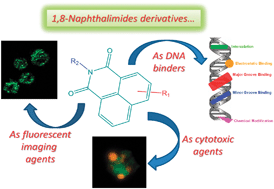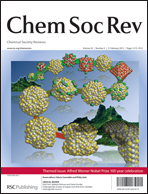Recent advances in the development of 1,8-naphthalimide based DNA targeting binders, anticancer and fluorescent cellular imaging agents†
Abstract
The development of functional 1,8-naphthalimide derivatives as DNA targeting, anticancer and cellular imaging agents is a fast growing area and has resulted in several such derivatives entering into clinical trials. This review gives an overview of the many discoveries and the progression of the use of 1,8-naphthalimides as such agents and their applications to date; focusing mainly on mono-, bis-naphthalimide based structures, and their various derivatives (e.g. amines, polyamine conjugates, heterocyclic, oligonucleotide and peptide based, and those based on metal complexes). Their cytotoxicity, mode of action and cell-selectivity are discussed and compared. The rich photophysical properties of the naphthalimides (which are highly dependent on the nature and the substitution pattern of the aryl ring) make them prime candidates as probes as the changes in spectroscopic properties such as absorption, dichroism, and fluorescence can all be used to monitor their binding to biomolecules. This also makes them useful species for monitoring their uptake and location within cells without the use of co-staining. The photochemical properties of the compounds have also been exploited, for example, for photocleavage of nucleic acids and for the destruction of tumour cells.

- This article is part of the themed collection: Alfred Werner Nobel Prize 100 year celebration

 Please wait while we load your content...
Please wait while we load your content...